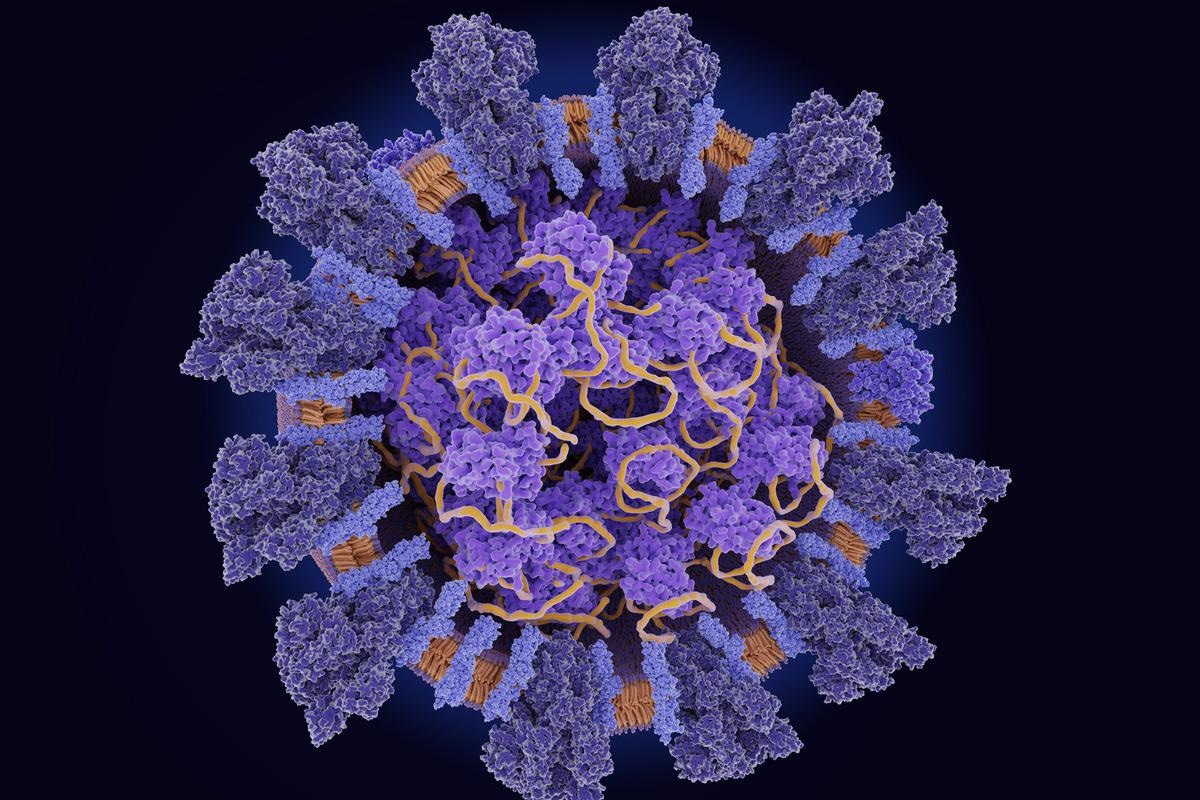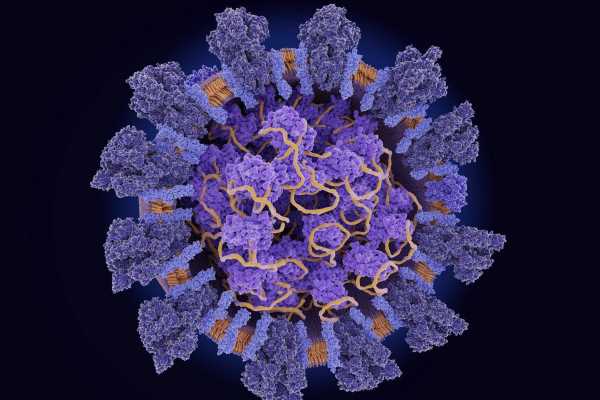There are four key structural proteins of severe acute respiratory syndrome coronavirus 2 (SARS-Cov-2). Most research focuses on the spike protein – which is largely responsible for the pathogenicity of the virus. Still, all four proteins could be vital targets for anti-coronavirus disease 2019 (COVID-19) drug development. Researchers have been investigating the phosphorylation of the nucleocapsid protein.
 Study: Emergence of glycogen synthase kinase-3 interaction domain enhances phosphorylation of SARS-CoV-2 nucleocapsid protein. Image Credit: Juan Gaertner/Shutterstock
Study: Emergence of glycogen synthase kinase-3 interaction domain enhances phosphorylation of SARS-CoV-2 nucleocapsid protein. Image Credit: Juan Gaertner/Shutterstock
There are four key structural proteins of severe acute respiratory syndrome coronavirus 2 (SARS-Cov-2). Most research focuses on the spike protein – which is largely responsible for the pathogenicity of the virus. Still, all four proteins could be vital targets for anti-coronavirus disease 2019 (COVID-19) drug development. Researchers have been investigating the phosphorylation of the nucleocapsid protein.
A preprint version of the study is available on the bioRxiv* server, while the article undergoes peer review.
The study
Glycogen synthase kinase (GSK)-3 is responsible for the phosphorylation of many endogenous and viral proteins, which depends on the ability of GSK-3 to bind protein-protein interaction. The GSK-3 interacting domain (GID) embedded in the substrates for GSK-3 helps improve the efficiency of self-phosphorylation.
The nucleocapsid is one of the proteins phosphorylated by GSK-3, and the researchers wished to examine the relationship between GID and nucleocapsid-GSK-3 interaction and phosphorylation. They found a L/FxxxLxxRL motif in the unstructured disordered region of the wild-type nucleocapsid protein. Following this, Lue to Glu substitution mutants were generated in the nucleocapsid protein (as hydrophobic residues are important in GSK-3 interaction) and transfected with HA-tagged GSK-3Beta and nucleotide expression vectors in HEK cells. Immunoprecipitation assays revealed that the nucleocapsid protein does interact with GSK-3, and point mutation of hydrophobic residues in N-GIS largely abolished the interaction with GSK-3. Despite this, the protein abundance of the nucleocapsid protein and the mutants was comparable.
To explore the interaction further, a mobility shift on a Phos-tag gel was used to examine the phosphorylation status of the nucleocapsid protein and mutants. This revealed that the mutation of the hydrophobic residues decreased the phosphorylation of the nucleocapsid protein but did not affect its stability. The mutants alongside the nucleocapsid protein were then treated with lambda protein phosphatase before another phos-tag gel, which showed the treatment increased the mobility shift of the nucleocapsid protein and the point mutants of L223, or L227. Still, the protein with both mutations was unaffected. The mobility shift of N-L223/227E was also unaffected.
The researchers suggested that GID provides the main phosphorylation of the nucleocapsid protein. In contrast, the lambda protein phosphatase treatment barely dephosphorylated it at all, indicating that the nucleocapsid protein undergoes oligomerization by phosphorylation.
To test this, a nucleocapsid-EGF fusion construct was generated and cotransfected with Flag-tagged nucleocapsid or L223/227E mutant. The immunoprecipitation assay showed that Flag-nucleocapsid interacts with nucleocapsid-EGFP, while the interaction between the nucleocapsid protein and the L223/227E mutant interaction decreased – indicating that the nucleocapsid does harbor GID, allowing interaction and phosphorylation by GSK-3. Further investigation showed that it is likely that this works similarly to the better determined Axin-GSK-3 binding structure.
As the kinase activity of GSK-3 is suppressed through the GID, the researchers followed this by examining the role of the nucleocapsid protein in GSK-3 kinase activity and signaling pathways. They found that overexpression of the nucleocapsid protein or the mutants did not affect the endogenous GSK-3 kinase activity, GSK-3 abundance, phosphorylation status on Ser 9 and Y216, and other downstream proteins were unaffected. This suggests that the nucleocapsid does not affect GISK-3 kinase activity.
Other coronaviruses typically cause minor symptoms alongside an upper respiratory infection. SARS-CoV and SARS-CoV-2, however, are members of the sarbecovirus lineage of beta-coronavirus’, and replicate in the lower respiratory tract with much more severe symptoms.
The researchers analyzed GID and SR-rich phosphorylation motifs amongst different coronavirus to understand better the role of GID in the evolution of the virus. They discovered that the sarbecovirus lineage nucleocapsid protein harbors a typical GID as well as a CDK1 phosphorylation site with a conserved pSPxK/R that could help phosphorylation of GSK-3. As well as this, the nucleocapsid protein in sarbecovirus lineages have a Gly-rich flexible linker between GID and SR-rich phosphorylation domain.
These differences lead them to suggest that CDK1 could help prime to phosphorylation of GSK-3 and that Gly-rich linker could help facilitate the phosphorylation of the nucleocapsid protein. They then tested this by generating nucleocapsid expression vectors with either substitution of CDK1 phosphorylation sites or GNGG linker to DNEIA that corresponded to sequences in HKU1 coronavirus.
The expression vectors were then transfected. Through western blot and immunoprecipitation analysis, the researchers showed similar protein abundance levels and binding capacity to GSK-3 of nucleotide and mutant nucleotide expression vectors. The mutation of the CDK1 phosphorylation site and Gly-rich linker showed decreased phosphorylation status compared to the ancestral nucleotide in phos-tag analysis – indicating the emergence of both these alongside the GID in sarbecovirus lineage could play a role in the phosphorylation of the nucleotide protein.
Conclusion
The authors have successfully explored the interactions between the nucleocapsid protein and GSK-3 and showed a strong connection to a more widely explored interaction. This could be very useful for other researchers. The interactions they have explored could potentially help identify new targets for drug development and further the understanding of coronaviruses in general.
*Important notice
bioRxiv publishes preliminary scientific reports that are not peer-reviewed and, therefore, should not be regarded as conclusive, guide clinical practice/health-related behavior, or treated as established information.
-
Yun, J. et al. (2022) "Emergence of glycogen synthase kinase-3 interaction domain enhances phosphorylation of SARS-CoV-2 nucleocapsid protein". bioRxiv. doi: 10.1101/2022.01.24.477037. https://www.biorxiv.org/content/10.1101/2022.01.24.477037v1
Posted in: Medical Science News | Medical Research News | Disease/Infection News
Tags: Assay, Coronavirus, Coronavirus Disease COVID-19, covid-19, Evolution, Immunoprecipitation, Kinase, Mutation, Nucleotide, Phosphatase, Phosphorylation, Point mutation, Protein, Research, Respiratory, SARS, SARS-CoV-2, Severe Acute Respiratory, Severe Acute Respiratory Syndrome, Spike Protein, Syndrome, Virus, Western Blot

Written by
Sam Hancock
Sam completed his MSci in Genetics at the University of Nottingham in 2019, fuelled initially by an interest in genetic ageing. As part of his degree, he also investigated the role of rnh genes in originless replication in archaea.
Source: Read Full Article
